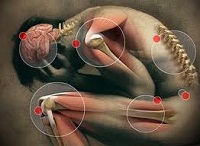 DEFINITION OF PAIN (IASP – INTERNATIONAL ASSOCIATION FOR THE STUDY OF PAIN)
DEFINITION OF PAIN (IASP – INTERNATIONAL ASSOCIATION FOR THE STUDY OF PAIN)
Pain is an unpleasant sensory and emotional experience accompanied by an actual or potential impairment, or is described as such.
WHAT IS CHRONIC PAIN?
Acute pain is the sensation activated by the nervous system when an injury or impairment or disease is manifested in the body and serves as a warning sign for the timely removal of the noxious factor in the search of pain aetiology. Thus, acute pain is useful, for it constitutes the protective alarm of the human organism.
However, when the alarm keeps on ringing continuously, it stops being useful; it becomes disturbing and has to cease. Chronic pain is continuous maybe for weeks, months, years and persists for more than the normal period of time required for the healing of a lesion or/and treatment of a disease. In this case, the pain itself has become a disease on its own that needs treatment, either aetiological –identifying the aetiology and applying a targeted therapy- or symptomatic –when the cause cannot be clearly identified despite the investigation. Common cases of chronic pain are headache, low back pain, arthralgia, neuropathic pain and cancer pain.
CHRONIC PAIN IN FIGURES
According to the AMERICAN ACADEMY OF PAIN MANAGEMENT, pain is a silent epidemic in the U.S.A. Fifty million Americans suffer from chronic pain due to diseases, disorders and accidents. If we also add 2 close relatives to each one of them, then 150 million people suffer, that is 50% of the American population. In addition, 25 more million people suffer from acute pain following a surgical operation or an accident. Approximately 2/3 of these people live in pain for over five years. Loss of productivity and daily activity due to pain is impressive. According to a study of the year 2000, 36 million Americans have lost their job due to pain, 50 million working days are lost annually and 83 million people report that pain has significantly affected their activities.
INCIDENCE OF CHRONIC PAIN COMPARED TO OTHER SEVERE DISEASES
Pain affects more Americans than diabetes mellitus, heart diseases and cancer do all together!!!
| ΠΑΘΗΣΗ | ΑΡΙΘΜΟΣ ΠΑΣΧΟΝΤΩΝ |
ΠΗΓΗ ΠΛΗΡΟΦΟΡΙΑΣ |
| Pain | 76.2 million | National Centers for Health Statistics (1) |
| Diabetes mellitus | 23.6 million diagnosed and estimated undiagnosed | American Diabetes Association (2) |
Coronary disease Infarct |
23,3 million | American Heart Association (3) |
| Cancer | 11 million | American Cancer Society (4) |
PREVALENCE/ INCIDENCE OF NEUROPATHIC PAIN IN VARIOUS DISEASES
• 20-24% of patients with diabetes present painful diabetic peripheral neuropathy
• 25-50% of patients with herpes zoster and mean age >50 develop post-herpetic neuralgia (>3 months after the rash elimination)
• 20% of women present pain after mastectomy
• One third of patients with cancer have neuropathic pain (alone or along with nociceptive pain)
• 7-37% of patients with low back pain may present related neuropathic pain
THE BURDEN OF PAIN IN EVERYDAY LIFE
Millions of people all over the world suffer from subacute and chronic pain and this results in huge annual costs related to health and rehabilitation. The cost of persisting refractory chronic pain leads to loss of working hours and, as a consequence, to reduction of their performance and decrease of productivity and revenue. According to statistical research conducted in the U.S.A. , reduced productivity due to pain, costs employers about 60 – 100 billion dollars annually.
Chronic pain seriously affects patients and their families. Pain undermines their quality of life and significantly limits their mental concentration, physical exercise, personal and social activities, even sleep and rest. All this often results in depression. Depression is the most common reaction to chronic pain and anxiety is the most common reaction to acute pain.
GENERAL ASSUMPTIONS
One could assume from the above mentioned statistical data that pain and its insufficient treatment constitute the major problem of modern times. In 1999 the AMERICAN PAIN SOCIETY announced that more than 4 out of 10 patients with moderate to severe pain cannot find satisfactory relief.
According to the journal CHRONIC PAIN IN AMERICA, people suffering from chronic pain have difficulty to find efficient physicians for treating their pain in an effective way. Pain specialists examine the patient and, in cooperation with the support group, treat acute and chronic pain, benign and malignant, with combination of drugs, modern interventional techniques and psychological support.
WHAT IS INTERVENTIONAL PAIN MANAGEMENT?
According to the American Society of Interventional Pain Physicians(ASIPP), interventional pain management includes the diagnosis and treatment of disorders related to pain.The objectives of interventional pain management is to limit or manage pain in the optimal way and improve the patient’s quality of life by applying minimally invasive techniques specially designed for the diagnosis and treatment of pain disorders. Interventional pain therapy also helps patients to resume soon to their daily life activities without being strongly dependent on drugs. Interventional Pain Practice is one of the most rapidly developed specialties worldwide. It is mainly practised by anaesthesiologists who can get accredited only by the World Institute of Pain (WIP) after taking special examinations. The specialty title is “Fellow of Interventional Pain Practice” (FIPP). It constitutes the intermediate therapeutic stage between conservative treatment (drugs, physiotherapy, kinesiotherapy) and surgical treatment of diseases causing subacute or chronic pain (e.g. sciatica due to herniated intervertebral disc).
Interventional therapeutic techniques are applied in the skull and spine, under local anaesthesia and fluoroscopic guidance with high accuracy and safety.












